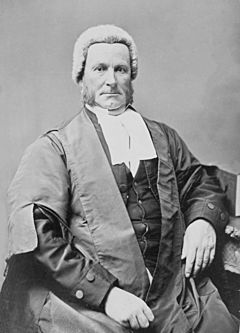William Stawell facts for kids
Quick facts for kids
Sir
William Foster Stawell
|
|
|---|---|

Stawell in 1872
|
|
| 1st Attorney-General of Victoria, Australia | |
| In office 1851–1857 |
|
| Succeeded by | Thomas Howard Fellows |
| 2nd Chief Justice of the Supreme Court of Victoria |
|
| In office 1857–1886 |
|
| Preceded by | William à Beckett |
| Succeeded by | George Higinbotham |
| (Appointed) Member of the Legislative Council of Victoria |
|
| In office 1851–1856 |
|
| Member of the Legislative Assembly of Victoria |
|
| In office 1855–1857 Serving with Archibald Michie and David Moore
|
|
| Constituency | Melbourne |
| Personal details | |
| Born | 27 June 1815 Old Court, County Cork, Ireland |
| Died | 12 March 1889 (aged 73) Naples, Italy |
| Nationality | British |
| Spouse | Mary Frances Elizabeth Greene |
| Children | Richard Rawdon Stawell (son) |
| Alma mater | Trinity College, Dublin, King's Inns, and Lincoln's Inn |
| Occupation | Lawyer and Barrister |
Sir William Foster Stawell (27 June 1815 – 12 March 1889) was an important British leader in Australia. He helped shape the government of Victoria, a state in Australia. Stawell was the first Attorney-General (chief legal advisor) of Victoria. He also served as the Chief Justice (main judge) of the Supreme Court of Victoria.
Contents
Early Life and Education
William Stawell was born in Old Court, County Cork, Ireland. He was one of ten children. His father was Jonas Stawell, and his mother was Anna. Her father was William Foster, a bishop.
Stawell went to Trinity College, Dublin, a famous university. He then studied law at King's Inns in Dublin and Lincoln's Inn in London. In 1839, he became a lawyer in Ireland. He traveled around Europe with friends before moving to Australia in 1842.
Life in Australia
In 1843, Stawell became a lawyer in the Port Phillip District. This area later became Victoria. He also owned large sheep farms. These farms were located near the Avoca River and Lake Wallace.
Stawell helped set up the first church rules for the new area. He worked with Charles Perry, who became the first bishop of Melbourne.
Becoming Attorney-General
Stawell was a top lawyer in the Port Phillip District. In 1851, the district became the independent Colony of Victoria. Stawell was chosen as its first Attorney-General on 15 July 1851. This made him a key member of the government.
Gold Rush Challenges
Soon after Stawell's appointment, gold was found in Victoria. This brought many people to the colony. Stawell had to create new rules and systems quickly. He helped set up a police force and rules for the goldfields. He also appointed judges and other officials. His strong leadership helped keep order. It prevented chaos when many new people arrived.
Stawell supported a system where miners paid for a license. This was instead of paying a tax on the gold they found. This license system caused problems. It was one of the main reasons for the Eureka Rebellion in Ballarat in 1854. Stawell was involved in the legal actions against the leaders of this rebellion.
Working with Others
Stawell often worked with little help from his colleagues. He was a very important part of the government. He worked with John O'Shanassy, a popular leader. Together, they passed many laws that helped Victoria grow. A politician at the time, Henry Samuel Chapman, called him "almost the only efficient man connected with the government."
Creating Victoria's Constitution
Stawell worked tirelessly. He often traveled long distances to visit remote areas. He would do this after spending all day in court or at government meetings.
He played a big part in writing the Constitution Act. This law gave Victoria its own elected government. Before this, the governor appointed many officials. After the Act, the people elected their leaders.
In 1856, Stawell was elected as a Member for Melbourne. He became the Attorney-General in the first elected government. In 1857, he became the Chief Justice of the Supreme Court. He was also given the title of Knight Bachelor. He served as the temporary leader of Victoria in 1873, 1875–1876, and 1884.
Later Life and Legacy
Stawell lived in Australia from 1843 until 1872. He then visited nearby colonies and New Zealand. In 1873, he took a two-year break and returned to Europe.
He was very interested in the Church of England. He was a member of its church council. In 1886, he retired from his judge position. He was then given the honor of KCMG. Stawell passed away in Naples, Italy, on 12 March 1889.
Places Named After Stawell
- The family home, D'Estaville, was built in 1859. It is still standing in Kew, a suburb of Melbourne.
- The town of Stawell, Victoria was named in his honor.
Family Life
In 1856, William Stawell married Mary Frances Elizabeth Greene. They had several children:
- Richard Rawdon Stawell (1864–1935) became a doctor.
- Anna Catherine Stawell married Sylvester J. Browne, a mining leader.
- Florence Melian Stawell (1869–1936) was a scholar who studied ancient languages and cultures.
- Mary Letitia Stawell (1865–1938) married Edward William Hawker, a politician.
See also
- Judiciary of Australia
- List of Judges of the Supreme Court of Victoria
- Stawell Chambers
- Heritage listing of Stawell Chambers

